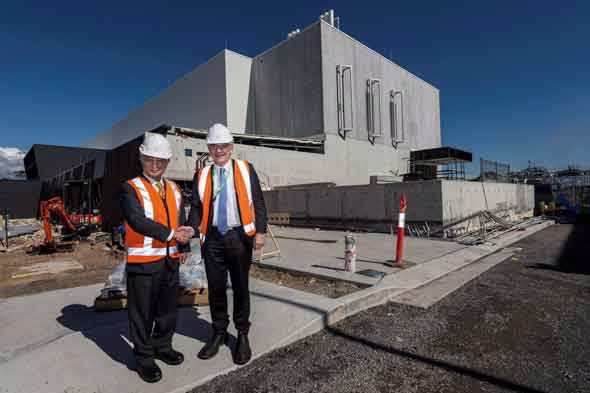
In Sydney today, the head of the world’s nuclear agency visited one of the world's emerging nuclear facilities – the new ANSTO Nuclear Medicine plant that will soon produce international-scale supplies of nuclear medicine.
Director General of the International Atomic Energy Agency (IAEA), Yukiya Amano (pictured above left), was at the Australian Nuclear Science and Technology Organisation (ANSTO) to learn about the status of construction.
The combination of the nearly complete $168.8 million ANSTO Nuclear Medicine Project (ANM) and the OPAL research reactor are two parts of an equation that will take Australian nuclear medicine all around the world.
Nuclear medicine is a vital element of modern medical systems and in Australia it is sourced from OPAL, enabling diagnosis and treatment of a variety of cancers, and heart, lung and skeletal conditions.
This Friday, on the eve of Science Week, OPAL will celebrate ten years since it first went critical, marking a decade of landmark research infrastructure and one of Australia’s most significant science investments.
CEO Dr Adi Paterson (pictured above right) said it was a privilege to host the Director General, and to tell him about the milestones achieved over the OPAL reactor’s first decade, and what is planned for the future.
“Since OPAL achieved its first sustained nuclear chain reaction, it has produced millions of doses of nuclear medicine and it's anticipated that one in two Australians will benefit from nuclear medicine at some point in their lifetime,” said Dr Paterson.
“Reactors such as OPAL are the only reliable way of producing the nuclear medicine molybdenum 99 (Mo-99) at the quality and scale needed by hospitals and nuclear medicine centres around the world.
“Global demand for potentially lifesaving molybdenum 99 (Mo-99) is increasing, while the reactors capable of supplying it are shutting down, and from next year ANSTO will step up to help fill that gap.”
Paterson said that while the nuclear medicine role is critical for ANSTO, it has been an overall decade of achievement for Australia’s OPAL reactor, and has a bright future ahead.
“Every week, OPAL assists industries in finding solutions, improving agricultural yields, conducting environmental studies and producing the major components of green energy,” he said.
“At ANSTO our significant achievements of the past sit alongside our vision for the future, as Mr Amano saw today, visiting the construction site of Australia’s $168.8 million investment in nuclear medicine for the world.
“The ANSTO Nuclear Medicine project is about the future – focused towards producing at a capacity to supply 25 per cent of the global demand for nuclear medicine by the end of 2017.
“The $168.8 million project is in the final phases of construction, having received its engine room of ten hot cells, and by the end of next year aim to reach full scale production of 10 million doses a year.”
Dr Paterson said ANSTO’s history and experience in nuclear science and technology, and particularly the production of nuclear medicine has seen the development of a hub of expertise at Lucas Heights.
“The nuclear science expertise developed in the last decade can be attributed to the international attraction and world class research possible thanks to OPAL, and soon ANM will be greatly adding to this,” he said.
Media contact: Phil McCall on 0438 619 987
Published: 09/08/2016


